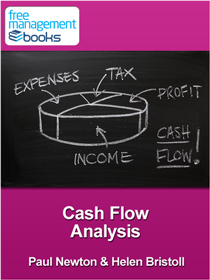Cash Flow Analysis - Free eBook in PDF Format
 |
 |
|
Book Description - ISBN 978-1-62620-956-5 (38 Pages)
This free eBook will help you to understand how cash flows are generated and what factors affect them. This skill is an integral part of making financial decisions that increase a firm's economic value or the capabilities of a nonprofit organization.
Chapter 1 - Cash Flow Analysis Definition
Cash flow is simply the flow of cash through the organization over time. Working capital is required to ensure that the organization is able to continue its day-to-day operations.
Chapter 2 - Managing Working Capital
The management of working capital involves actively controlling inventories, accounts receivable, accounts payable, and cash. The effective management of working capital can increase profitability in the private sector and reduce the amount of capital required by nonprofit organizations.
Chapter 3 - Cash Flow
Cash includes all of the money that the organization has in bank accounts and short-term investments that can quickly be turned into available cash. Cash flow can refer to actual past flows or projected future flows.
Chapter 4 - Changes in the Cash Account
The way in which the 'cash account' is used in published accounts is to some extent counter-intuitive. When owner's equity increases, the cash account increases. When an asset (other than cash) increases, the cash account decreases. When a liability increases, the cash account increases.
Chapter 5 - Direct Format Cash Flow Statement
Presenting cash flow using the 'direct' method is straightforward but not very useful because it does not show net income or make any attempt to explain the difference between any net income and net cash flow.
Chapter 6 - Indirect Format Cash Flow Statement
An indirect format cash flow statement begins with net income and adjusts for changes in account balances that affect available cash. It is slightly more difficult to understand initially but has far more potential for analysis. A statement prepared using this method has four distinct sections: operations, investing, financing, and supplemental information.
Chapter 7 - Cash Flow from Operations
Adjustments are all the operating items that had an impact on cash that were not included in the income statement. Depreciation is recorded each month after the asset is put into use yet no cash changes hands as a result of these depreciation entries. Cash received from customers would would increase the cash figure but decrease the accounts receivable figure.
Chapter 8 - Cash Flow from Investments
Capital expenditures describes the amount spent for all fixed assets that are not charged to expense when purchased but are recorded on the organization's balance sheet. When investment is sold the net proceeds of the sale, except for the gain or loss on sale (which appears in the income statement), become an additional source of cash.
Chapter 9 - Cash Flow from Financing
Financing activities include the inflow of cash from investors such as banks and shareholders, as well as the outflow of cash to shareholders as dividends.
| You will learn: |
|
![]()
![]()
Well Organized and Easy to Follow
Cash flow has to be one of the most misunderstood points of management by a large section of people. The idea that a company can be 'successful' in terms of sales and yet fail because of a lack of working capital is not something that non-finance people have an easy time understanding. Reading the eBook helped me to think about new ways in which to explain the process and importance of cash flow to individuals who might not understand it otherwise. Overall, I felt this book did a good job of highlight key points and organizing the material in a manner that was easy to follow.
I very much enjoyed the section on debtors, and feel that it should be required reading for anyone in a position of management. Having uncollected debt over a period of time can have a major strain on the entire organization, and everyone, not just those in accounting, needs to understand this point. Salespeople can be helpful in the collections process, as can upper management. When a consistent system of collections is followed, the open amount of debt can be reduced and the cash flows improved.
Likewise with the debtors section, I thought the creditors section made some good points regarding payment policies and how they can affect your flexibility and image as an organization. I've always subscribed to the school of 'don't pay until you absolutely have to', just as a matter of keeping my money as long as possible. However, the book raises a good point about operating cash in times of crisis. If you already string out your creditors as long as possible, you can't use that as a way of finding more cash during tough times. Your organization will be accustomed to running lean in that sense, and there will be no flexibility in slow-paying the bills to uncover some available funds. I had not thought about it in this way, and will consider that when I am scheduling creditor payments from now on.
Beyond the general thoughts on creditors and debtors, this book also gets into the nitty-gritty on actually putting together a cash flow statement. This is a good review for more experienced managers, and great info for those just starting out. A cash flow statement is (obviously) no good if it is inaccurate or hard to read, so follow the basic steps outlined here will lead you to creating a solid statement that provides all of the needed information.
Perhaps the most useful portion of this book for someone that doesn't come from an accounting background is the examples of how the cash account is affected by typical business transactions. I have done a lot of accounting in my past so this section was not necessary for me specifically, but I can see the value in it. The book is careful to explain how each entry on the accounting ledger changes specific accounts, and how that information can be useful.
Given how important the topic of cash flow is to any operation organization, I think this eBook is definitely worth the time to read through and educate yourself or your team. Even if you are already comfortable with this topic, there are several great points within the book that you might have either forgotten about through the years, or never thought of in the first place. While you won't be a CPA when you finish with this text, you will have a clearer picture of how to keep an accurate cash flow statement, and what valuable information it can provide.
Bill Baldwin
I'll Keep it for Reference
I downloaded this one after reading the Accounting Principles one. This one is probably more detailed than I need but the introduction explained some things I didn't know in a way that was easy to understand. I'll keep it for reference because its easy to find any specific information I might need in the future. BTW Can you do something on budgeting?
Henry F

